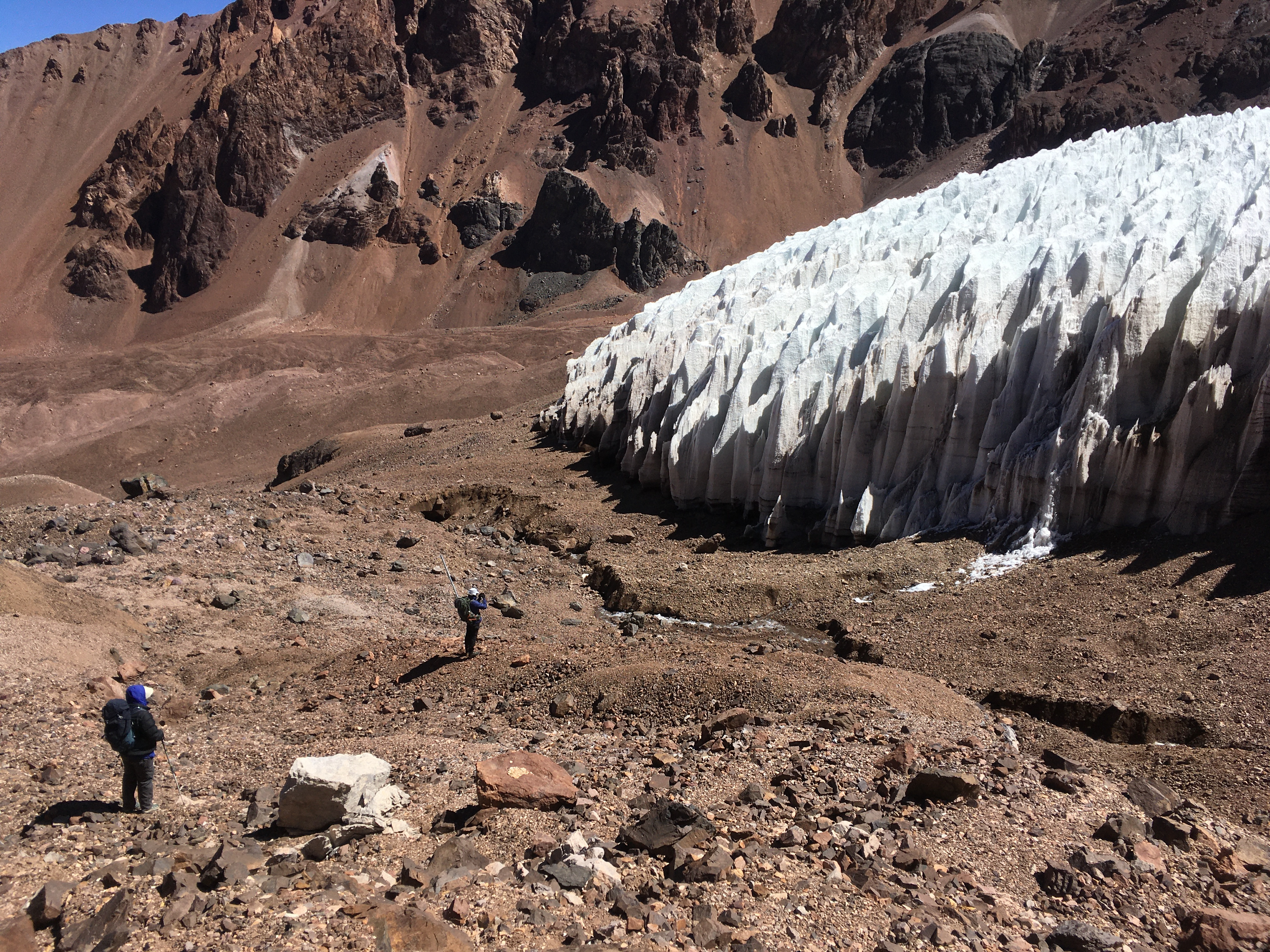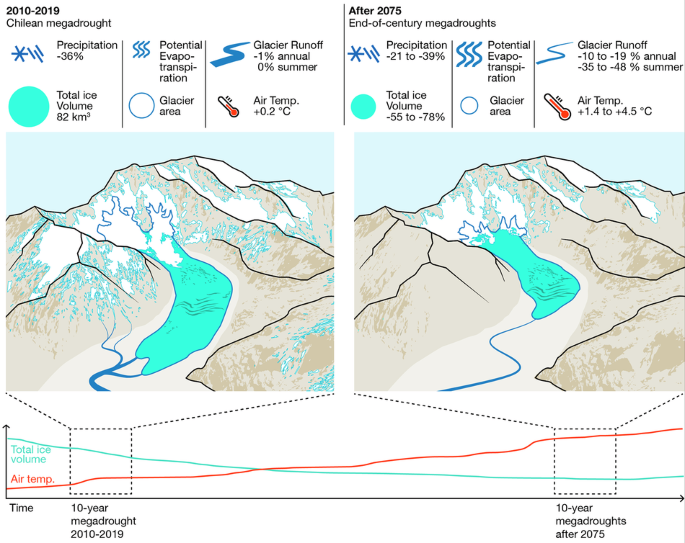Andes glaciers are losing their capacity to sustain rivers during severe droughts
Published in Earth & Environment

The Chilean megadrought
In the early 2010s, a severe and persistent drought started in central Chile and western Argentina. Extending roughly from 30°S to 40°S and from the Pacific coast to the headwaters on the Argentinean side, this event has lasted for more than a decade, with annual precipitation deficits reaching up to 40%. At first, many thought it was just another dry spell linked to El Niño Southern Oscillation (ENSO), typically lasting a year or two before wetter conditions returned. However, after four or five consecutive dry years, scientists began to suggest that this was something different - a megadrought (Garreaud et al., 2017; 2020). The precipitation deficit had negative cascading effects on streamflow (Masiokas et al., 2019), soil moisture (González-Reyes et al., 2024), forest fires (González et al., 2018) and lake levels (Fuentealba et al., 2021). The megadrought has also fueled environmental conflicts over water availability, generating disputes between local communities—demanding greater access to water and stronger ecosystem protection—and industries driving economic growth, such as agriculture and mining.
Along the border between Chile and Argentina lies the Southern Andes mountains, which are populated by large and captivating glaciers (Figure 1). Here, snow cover area was drastically reduced (Cordero et al., 2024), and glaciers suffered strong mass losses (Dussaillant et al., 2019). But, to what extent was ice melt able to compensate for the lack of precipitation in headwater catchments? And what might happen if a similar event occurs in the future, when glaciers will be much smaller due to ongoing retreat? We formed a group of researchers from Chile, Switzerland, Austria and New Zealand to answer these questions and quantify past and future glacier responses to megadroughts in the Andes.

The decreasing buffering role of glaciers
First, we set up a glacio-hydrological model to simulate the response of glaciers to the megadrought in the period 2010-2019 compared to the previous decade, when glaciers were close to a neutral balance. Our study covered the 100 largest glaciers in the Southern Andes between 30°S and 40°S, accounting for processes such as the insulating effect of supraglacial debris, snow avalanching and seasonal albedo changes. We found that during the megadrought, annual snow accumulation decreased by 36% on average, with extremely dry years like 2019 reaching deficits of 66%! Remarkably, ice melt almost completely offset the snow deficit at the glaciers’ termini, leading to only a ~2% reduction in glacier runoff compared to the reference decade.
Next, we wanted to understand how glaciers will evolve during the next decades. We forced our model with climate projections under two greenhouse gas emission scenarios to simulate glacier evolution throughout the 21st century. Air temperatures over our selected glaciers are projected to rise by 1.5°C to 4.7°C by 2100, while precipitation may remain similar to present levels, except in the most severe scenarios where a more marked decrease appears towards the end of the century. As a result, we project that our selected glaciers will lose between 55% and 78% of their volume by 2100.
Finally, we looked for megadrought episodes within the future climate projections after 2075, i.e. once the glaciers have considerably reduced their size. These simulations reveal that during such events, glacier runoff could decline by 20% annually and by up to 48% in summer compared to 2000-2009 (Figure 2).

What lies ahead?
Our findings show that during the Chilean megadrought, ice melt helped compensate for reduced snowfall, sustaining meltwater discharge from glaciers. However, if a similar megadrought occurs later this century, this buffering capacity will be greatly diminished. In downstream areas, reduced ice melt combined with higher evapotranspiration could sharply decrease water availability for people, agriculture and ecosystems. Preparing our water systems for a future with less glacier meltwater during prolonged droughts is therefore essential for climate resilience in the Andes.
References
Cordero, R. R., Feron, S., Damiani, A., MacDonell, S., Carrasco, J., Pizarro, J., Karas, C., Jorquera, J., Sepulveda, E., Cabello, F., Fernandoy, F., Wang, C., Khan, A. L., and Casassa, G.: Rapid decline in extratropical Andean snow cover driven by the poleward migration of the Southern Hemisphere westerlies, Sci. Rep., 14, 26365, https://doi.org/10.1038/s41598-024-78014-0, 2024.
Dussaillant, I., Berthier, E., Brun, F., Masiokas, M., Hugonnet, R., Favier, V., Rabatel, A., Pitte, P., and Ruiz, L.: Two decades of glacier mass loss along the Andes, Nat. Geosci., 12, 802–808, https://doi.org/10.1038/s41561-019-0432-5, 2019.
Fuentealba, M., Bahamóndez, C., Sarricolea, P., Meseguer-Ruiz, O., and Latorre, C.: The 2010–2020 “megadrought” drives reduction in lake surface area in the Andes of central Chile (32o - 36oS), J. Hydrol. Reg. Stud., 38, https://doi.org/10.1016/j.ejrh.2021.100952, 2021.
Garreaud, R. D., Alvarez-Garreton, C., Barichivich, J., Pablo Boisier, J., Christie, D., Galleguillos, M., LeQuesne, C., McPhee, J., and Zambrano-Bigiarini, M.: The 2010-2015 megadrought in central Chile: Impacts on regional hydroclimate and vegetation, Hydrol. Earth Syst. Sci., 21, 6307–6327, https://doi.org/10.5194/hess-21-6307-2017, 2017.
Garreaud, R. D., Boisier, J. P., Rondanelli, R., Montecinos, A., Sepúlveda, H. H., and Veloso-Aguila, D.: The Central Chile Mega Drought (2010–2018): A climate dynamics perspective, Int. J. Climatol., 40, 421–439, https://doi.org/10.1002/joc.6219, 2020.
González, M. E., Gómez-González, S., Lara, A., Garreaud, R., and Díaz-Hormazábal, I.: The 2010–2015 Megadrought and its influence on the fire regime in central and south-central Chile, https://doi.org/10.1002/ecs2.2300, 2018.
González-Reyes, Á., Christie, D. A., Schneider-Valenzuela, I., Venegas-González, A., Muñoz, A. A., Hadad, M., Gipoulou-Zúñiga, T., Tapia-Marzán, V., Gibson-Carpintero, S., Santini-Junior, L., Lequesne, C., and Villalba, R.: Recent multispecies tree-growth decline reveals a severe aridity change in Mediterranean Chile, Environ. Res. Lett., 19, 2024.
Masiokas, M. H., Cara, L., Villalba, R., Pitte, P., Luckman, B. H., Toum, E., Christie, D. A., Le Quesne, C., and Mauget, S.: Streamflow variations across the Andes (18°–55°S) during the instrumental era, Sci. Rep., 9, 1–13, https://doi.org/10.1038/s41598-019-53981-x, 2019.
Follow the Topic
-
Communications Earth & Environment

An open access journal from Nature Portfolio that publishes high-quality research, reviews and commentary in the Earth, environmental and planetary sciences.
Related Collections
With Collections, you can get published faster and increase your visibility.
Geology of the Moon
Publishing Model: Hybrid
Deadline: Jan 31, 2026
Drought
Publishing Model: Hybrid
Deadline: Dec 31, 2025

Please sign in or register for FREE
If you are a registered user on Research Communities by Springer Nature, please sign in